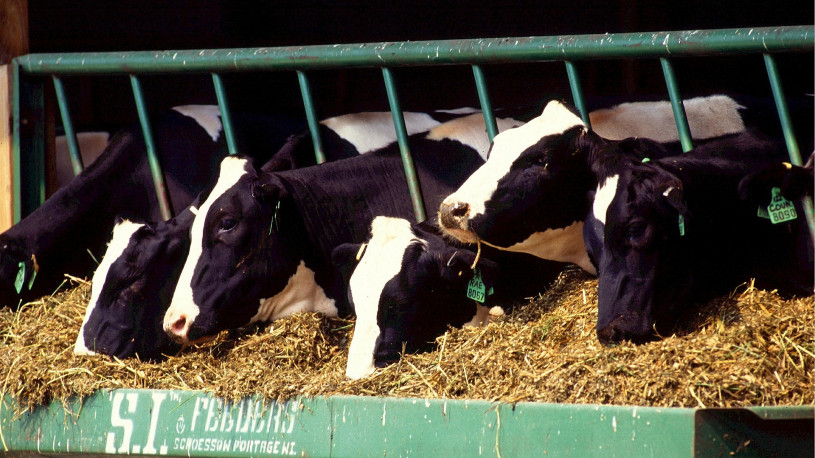-
Monocalcium Phosphate Fears and Forecasts
 Continue Reading
Continue ReadingThere have been numerous reports of an impending crash in the price of monocalcium phosphate of late. But given the growing demand for food, is it really likely that the price of MCP will fall?
World renowned experts such as Juan von Gemet, one of the principal consultants at CRU Group, stated recently that he foresees much weaker prices for phosphate products. He is not alone. Many in the animal feed sector also envisage a price drop in the short to medium-term, such as industry journal FeedNavigator, which recently reported that, “The inorganic feed phosphate (IFP) market is suffering due to multiple factors including over-capacity, low feed demand, the rise of substitute products, and growing environmental concerns.”
These thoughts are supported by expected drops in beef prices in US markets. As the American industry journal CattleNetwork, reports, “Profits will be harder to find for cattlemen in 2017, but there will be opportunities. That’s the consensus of economists who see an industry struggling to cope with increasing supplies, volatile markets, and meddlesome regulations.”
John Nalivka, president of Oregon-based Sterling Marketing, is even more precise in his outlook for cattle prices, stating that, “in 2017 I’m projecting a loss of $21 per cow.” This low forecast is despite his prediction that, “feed costs will go down sharply.”
Contrary to short-term slump predictions, are predictions of long-term gains.
In a recent interview with the industry journal, FeedInfo, Zorica Popovic, General Manager of the Elixir Group, a key player in animal feed phosphate markets in Europe, said, “We do not see any significant obstacles that can have a negative impact on the growth of consumption of IFP in Europe. Consumption of IFP in South East Europe has its variations related to shifts in volume of livestock production. Those are more or less seasonal, and are affected by fresh meat price fluctuations, which is characteristic for developing markets. Even the trends we are seeing with regard to the use of phytase in the coming years will not significantly affect the current volume of consumption of IFP in South East Europe.”
She similarly down-played future threats to the market, when she said, “In the long term, alternative sources of phosphorus, and technology for its processing, are inevitable because of limited phosphate reserves. If the use of alternative sources of phosphorus is going to increase, this could have a certain impact on the decrease of phosphate ore prices, but at the same time, it would cause increases in alternative raw material prices.”
She continues by optimistically adding that, “The competitiveness of alternative and low grade raw materials also depends on the price of phosphate ore, which has been low in recent years. In a high price environment, competition exists. But in case where low price levels prevail; competition is reduced.”This long-term optimism is supported by analysis from MarketResearchReport, which states that, “The global monocalcium phosphate market has seen remarkable growth over the past few years, and it is expected that the market will keep on expanding during the forecast period. The growing [number of] applications [for monocalcium phosphate] is resulting in increased demand across the globe.”
The study continues by outlining the healthy growth that is expected for the sector, declaring that, “World consumption of monocalcium phosphate (29% of the world total) is forecast to grow at an average annual rate of 2.5% during 2015–20. Growth will be led by China at about 7% per year during 2015–20, followed by Other Asia (about 3.5% per year), Africa and the Middle East, the United States, and Central and South America.”
Meanwhile, analysis of MCP markets by industry consultants IHS, confirms a comfortable rate of growth, stating, “Consumption of feed-grade calcium phosphates is forecast to grow at 2.0% annually during 2015–20, led by China at 4.6%, Africa and the Middle East at 2.5%, and the United States at 0.9%.”
So what can animal feed manufacturers and traders make of these conflicting opinions? Is there to be a short-term drop in MCP prices, or are the predictions of steady market growth closer to the truth?The fact is, the monocalcium phosphate market is a complicated one. While there is a great deal of secrecy among phosphate suppliers and agriproduct producers, there is also great desire for cooperation and mutual assistance to make improved animal feed.
Overall, while the number of phosphate handling facilities is due to increase in the next few years, increasing supply, their is still good reason for prices to remain buoyant. Long-term population growth and increased global wealth, especially in emerging economies such as India and China, give good cause for stable and/or increased demand for MCP.
As Popovic says, “Overall, we believe that changes in the market are less likely in the near future, and on that basis, we do not expect a significant shift in the feed phosphates market in the next few years.”
Or can anyone really be that certain about monocalcium phosphate prices?Photo credit: PAR
-
The Future of Animal Feed Markets
 Continue Reading
Continue ReadingIn the last few years, the animal feed industry has experienced an amazing period of discovery. Investment in research has been high, governments and international bodies have begun to realise the rising cost (and possible shortage) of food and so have started to step in, animal welfare groups have made great in-roads to improve industry standards, and numerous ground breaking products have been launched. Twenty years ago, the idea of cattle being fed insect meal, or microbial algae pellets would have been seen as pure science fiction, whereas today they are emerging industries.
The need for animal feed innovation was recently summed up by Dejan Miladinovic of the Norwegian University of Life Sciences, who explained the biology behind mankind’s need for improved animal feeds, when he wrote, “Optimally, an adult person needs to consume 60g of protein per day. To feed enough protein to the world’s population by 2050, about 790 million tonnes of protein will be required. This number is 50% more than today’s production. Beef cattle need about 100kg of feed to produce 5kg of body-mass, which could be interpreted as 1.3kg of pure protein.”
By this maths, the optimal protein requirement of a person for 21 days requires 100kg of animal feed.
While the logic in this scenario is rudimentary, the need for the animal feed industry to develop is clear. While non-meat sources of protein are available, the fact remains that our grandchildren’s well-being is dependent on improvements in the way we feed our livestock.
Miladinovic outlined our basic processes of manufacturing animal feed in a recent article for AllAboutFeed, when he said, “Feed raw material sources can be defined through three generations. First generation feed sources are commercially available. However, it is in direct competition with human food supply and depends on vast resources of arable land, irrigation and fertilisers. The second generation is less competitive with human food and not based on arable land and irrigation. Second generation feed sources are based on insects and microbes and its usage is challenging due to getting into new technologies and unknown demand. A third generation of aqua feed source is recapturing nutrients from, for example, dairy and pig farms’ wastewater. Science is already developing technologies that can recover phosphorous and nitrogen from manure. These technologies are economically feasible, however markets are quite immature.”
But while he does note the progress made, and the advancement of ‘immature markets’, he also notes the need to, “start the feed-protein revolution to ensure that the world population will be able to have access to food in the future.”
If his theory is correct, then the animal feed industry has some serious work to do to provide sufficient meat for the world’s growing population. The year 2050 is geologically tomorrow, and although insect feed and high-protein canola meal diets may sound high-spec, in terms of future demand, the animal feed industry is losing ground.
Or is Miladinovic wrong?Photo credit: soyatech
-
Animal Feed Researchers Find No Growth Benefit in Dietary Fat Additive
 Continue Reading
Continue ReadingWith global meat demand on the rise, and with the cost of food production at an all time high, there has been increased focus among governments, research teams and agribusiness leaders to improve the quality of animal feed. Today’s livestock are fed such high-performing products that nothing is left to chance in ensuring healthy, well-nourished animals.
One such example of this is a recent study from the University of Illinois that analysed the impact of adding fat supplements to pig feed in diets with a high canola meal content. In conclusion, the researchers were able to prove that, “adding supplemental dietary fat is not necessary to avoid reduced growth performance when replacing soybean meal with canola meal in diets fed to weanling pigs.”
The study focused on the use of canola meal as a feed ingredient, as it has a high protein content, and so can be used as a substitute for soybean meal in pig diets. Modern varieties of canola have even been selectively grown with thinner seed coats, and so have less fibre than conventional canola meal.
Speaking of the study, Hans Stein, professor of animal sciences at the University of Illinois said, “Recently, it’s been reported from several experiments that up to 40 percent canola meal may be used in diets fed to weanling pigs without negatively affecting growth performance. However, dietary fat was used as a supplement in all of those experiments to maintain constant net energy among diets.”
As the online science journal Phys.org reports, “Stein and his team formulated four diets by adding 20 or 30 percent conventional or high protein canola meal to a corn-soybean meal basal diet. The energy content of these diets ranged from 2299 kcal/kg net energy (NE) in the 30 percent canola meal diets to 2402 kcal/kg in the 20 percent high protein canola meal diets.” The study goes on to explain how, “Four additional diets were identical to the first four diets except that choice white grease was added, so that each diet contained 2452 kcal/kg NE.”
The results showed that the addition of white grease had no impact on the pigs’ body weight. As the study, which has been published in the Journal of Animal Science, states, “There were no differences in Gain to Feed ratio or in final Body Weight among pigs fed the control diet and pigs fed canola meal diets.”Instead, the report found that, “Pigs fed diets without supplemental fat had greater average daily gain and average daily feed intake than pigs fed the diets with constant net energy.” While, “Average daily gain, average daily feed intake, gain to feed ratio, and final body weight were not influenced by concentration of canola meal in the diets.”
“The results of this experiment confirmed that it is not necessary to maintain constant Net Energy among diets containing canola meal,” said Stein.How this study will impact animal feed additives markets has yet to be seen, but for now it appears that those focused on trading fat additives to feed have cause for concern. But beyond that, as the animal feed industry becomes ever more scientific, other feed additive traders may also start to worry about the true value of their agrichemical products.
Photo credit: threadnbutter
